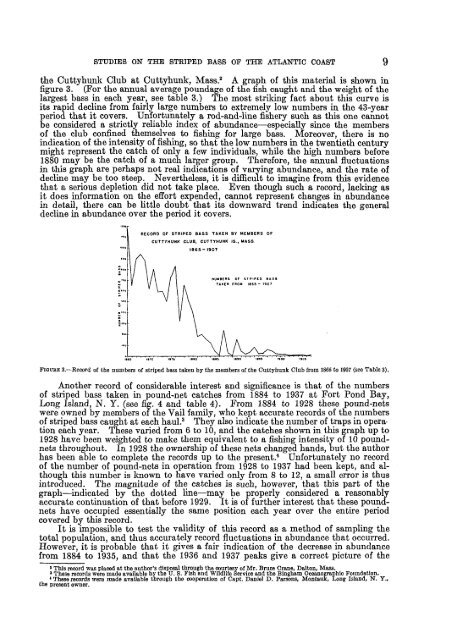Fishery bulletin of the Fish and Wildlife Service - NOAA
Fishery bulletin of the Fish and Wildlife Service - NOAA
Fishery bulletin of the Fish and Wildlife Service - NOAA
You also want an ePaper? Increase the reach of your titles
YUMPU automatically turns print PDFs into web optimized ePapers that Google loves.
STUDIES ON THE STRIPED BASS OF THE ATLANTIC COAST 9<br />
<strong>the</strong> Cuttyhunk Club at Cuttyhunk, Mass. 2 A graph <strong>of</strong> this material is shown in<br />
figure 3. (For <strong>the</strong> annual average poundage <strong>of</strong> <strong>the</strong> fish caught <strong>and</strong> <strong>the</strong> weight <strong>of</strong> <strong>the</strong><br />
largest bass in each year, see table 3.) The most striking fact about this curve is<br />
its rapid decline from fairly large numbers to extremely low numbers in <strong>the</strong> 43-year<br />
period that it covers. Unfortunately a rod-<strong>and</strong>-line fishery such as this one cannot<br />
be considered a strictly reliable index <strong>of</strong> abundance—especially since <strong>the</strong> members<br />
<strong>of</strong> <strong>the</strong> club confined <strong>the</strong>mselves to fishing for large bass. Moreover, <strong>the</strong>re is no<br />
indication <strong>of</strong> <strong>the</strong> intensity <strong>of</strong> fishing, so that <strong>the</strong> low numbers in <strong>the</strong> twentieth century<br />
might represent <strong>the</strong> catch <strong>of</strong> only a few individuals, while <strong>the</strong> high numbers before<br />
1880 may be <strong>the</strong> catch <strong>of</strong> a much larger group. Therefore, <strong>the</strong> annual fluctuations<br />
in this graph are perhaps not real indications <strong>of</strong> varying abundance, <strong>and</strong> <strong>the</strong> rate <strong>of</strong><br />
decime may be too steep. Never<strong>the</strong>less, it is difficult to imagine from this evidence<br />
that a serious depletion did not take place. Even though such a record, lacking as<br />
it does information on <strong>the</strong> effort expended, cannot represent changes in abundance<br />
in detail, <strong>the</strong>re can be little doubt that its downward trend indicates <strong>the</strong> general<br />
decline in abundance over <strong>the</strong> period it covers.<br />
RECORD OF STRIPED BASS TAKEN BY MEMBERS OF<br />
CUTTYHUNK CLUB, CUTTYHUNK IS., MASS.<br />
1865-1907<br />
FIGURE 3,—Record <strong>of</strong> <strong>the</strong> numbers <strong>of</strong> striped bass taken by <strong>the</strong> members <strong>of</strong> <strong>the</strong> Cuttyhunk Club from 1865 to 1907 (see Table 3).<br />
Ano<strong>the</strong>r record <strong>of</strong> considerable interest <strong>and</strong> significance is that <strong>of</strong> <strong>the</strong> numbers<br />
<strong>of</strong> striped bass taken in pound-net catches from 1884 to 1937 at Fort Pond Bay,<br />
Long Isl<strong>and</strong>, N. Y. (see fig. 4 <strong>and</strong> table 4). From 1884 to 1928 <strong>the</strong>se pound-nets<br />
were owned by members <strong>of</strong> <strong>the</strong> Vail family, who kept accurate records <strong>of</strong> <strong>the</strong> numbers<br />
<strong>of</strong> striped bass caught at each haul. 3 They also indicate <strong>the</strong> number <strong>of</strong> traps in operation<br />
each year. These varied from 6 to 10, <strong>and</strong> <strong>the</strong> catches shown in this graph up to<br />
1928 have been weighted to make <strong>the</strong>m equivalent to a fishing intensity <strong>of</strong> 10 poundnets<br />
throughout. In 1928 <strong>the</strong> ownership <strong>of</strong> <strong>the</strong>se nets changed h<strong>and</strong>s, but <strong>the</strong> author<br />
has been able to complete <strong>the</strong> records up to <strong>the</strong> present.* Unfortunately no record<br />
<strong>of</strong> <strong>the</strong> number <strong>of</strong> pound-nets in operation from 1928 to 1937 had been kept, <strong>and</strong> although<br />
this number is known to have varied only from 8 to 12, a small error is thus<br />
introduced. The magnitude <strong>of</strong> <strong>the</strong> catches is such, however, that this part <strong>of</strong> <strong>the</strong><br />
graph—indicated by <strong>the</strong> dotted line—may be properly considered a reasonably<br />
accurate continuation <strong>of</strong> that before 1929. It is <strong>of</strong> fur<strong>the</strong>r interest that <strong>the</strong>se poundnets<br />
have occupied essentially <strong>the</strong> same position each year over <strong>the</strong> entire period<br />
covered by this record.<br />
It is impossible to test <strong>the</strong> validity <strong>of</strong> this record as a method <strong>of</strong> sampling <strong>the</strong><br />
total population, <strong>and</strong> thus accurately record fluctuations in abundance that occurred.<br />
However, it is probable that it gives a fair indication <strong>of</strong> <strong>the</strong> decrease in abundance<br />
from 1884 to 1935, <strong>and</strong> that <strong>the</strong> 1936 <strong>and</strong> 1937 peaks give a correct picture <strong>of</strong> <strong>the</strong><br />
» This record was placed at <strong>the</strong> author's disposal through <strong>the</strong> courtesy <strong>of</strong> Mr. Bruce Crane, Dalton, Mass.<br />
' These records were made available by <strong>the</strong> U. S. <strong>Fish</strong> <strong>and</strong> <strong>Wildlife</strong> <strong>Service</strong> <strong>and</strong> <strong>the</strong> Blngham Océanographie Foundation.<br />
4 These records were made available through <strong>the</strong> cooperation <strong>of</strong> Capt. Daniel D. Parsons, Montauk, Long Isl<strong>and</strong>, N. Y.,<br />
<strong>the</strong> present owner.

















